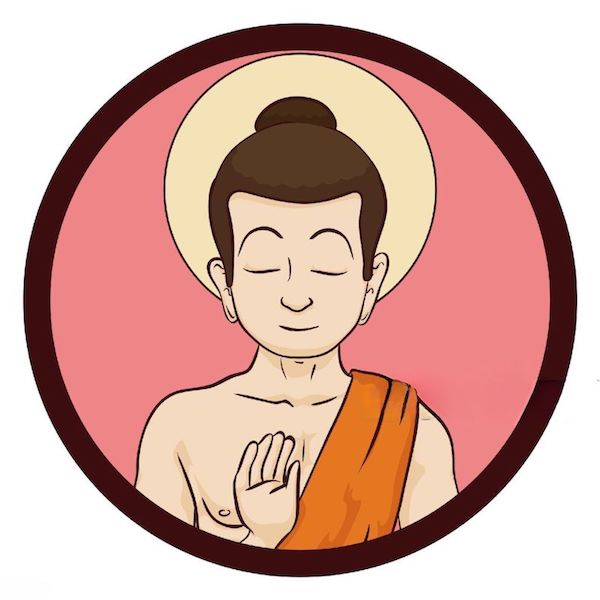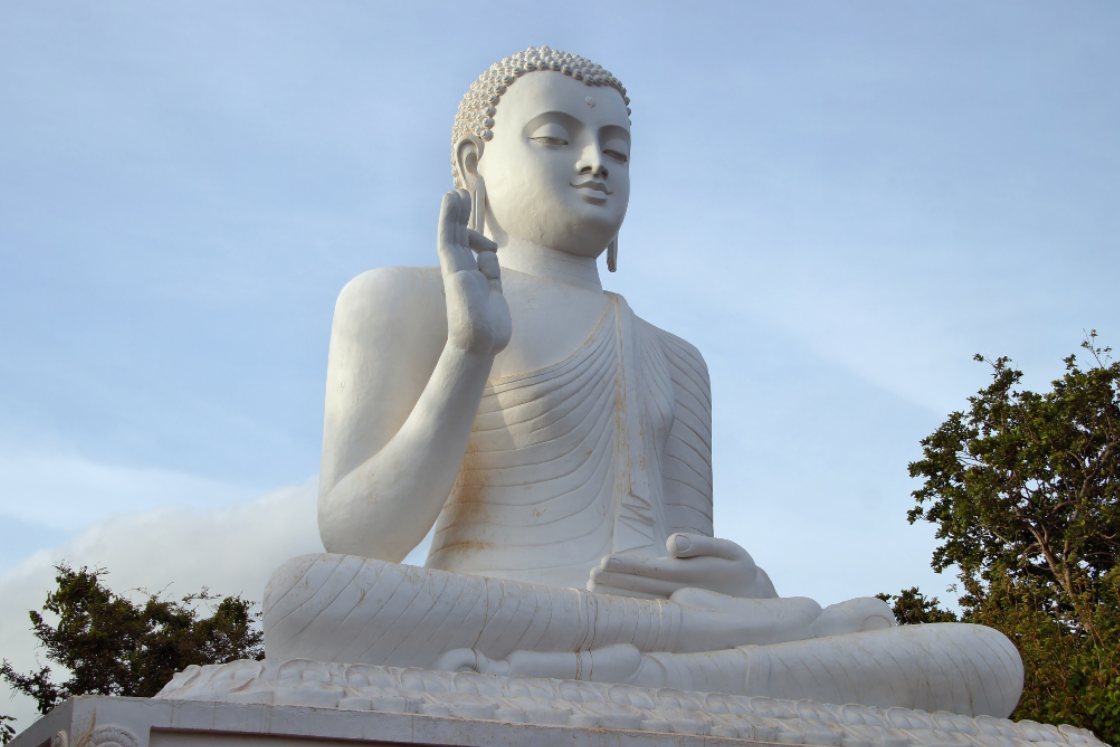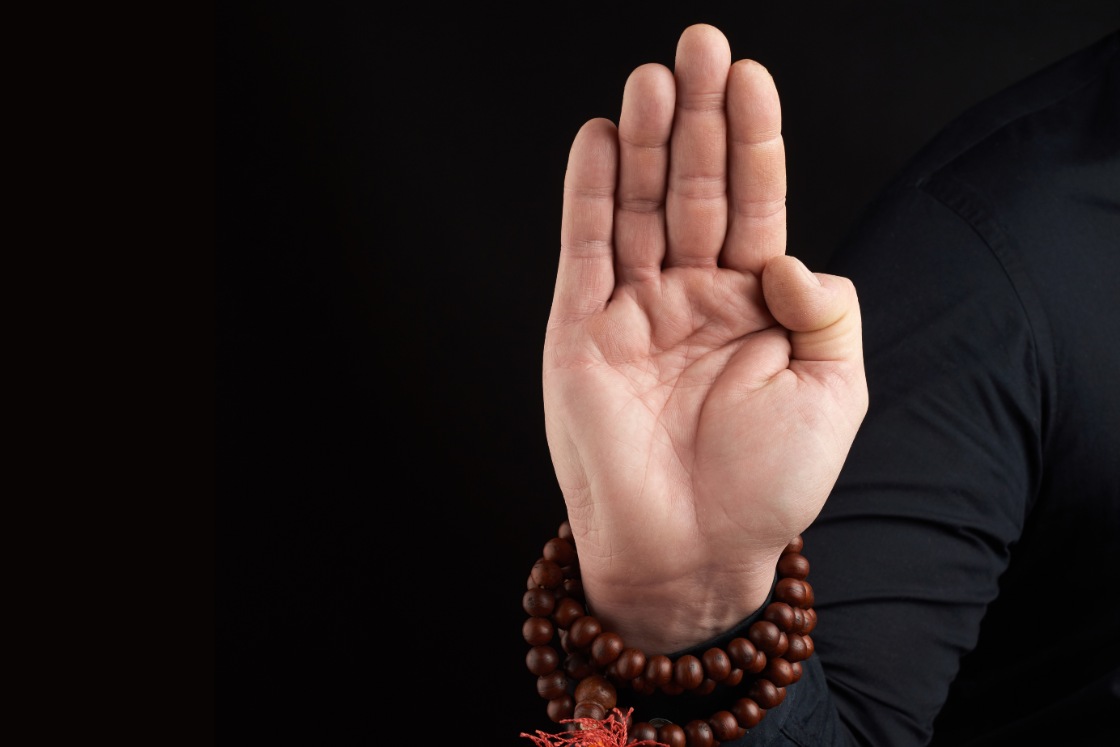
Abhaya Mudra is a hand gesture generally known as the “Gesture of Fearlessness.” It entails elevating the suitable hand with the palm going through outward, symbolizing security and peace. This gesture is deeply rooted in numerous dharmic traditions, together with yoga, meditation, and non secular practices. It’s typically depicted in Buddhist artwork, representing safety and calming fears.
Past its bodily type, Abhaya Mudra carries important religious that means. It helps practitioners embrace inside energy and overcome fears. Utilized in each religious practices and day by day life, it promotes a way of safety and confidence.
Which means & significance
The time period “Abhaya Mudra” comes from Sanskrit, the place “Abhaya” means “fearlessness” and “Mudra” means “gesture.” So, Abhaya Mudra means “the gesture of fearlessness.” This mudra symbolizes being free from worry and feeling protected. By utilizing this gesture, practitioners purpose to beat their fears and achieve inside energy.
The Abhaya Mudra is carried out with the suitable hand raised, palm going through outward. It exhibits a dedication to rise above ignorance and observe the trail of righteousness. Usually, the left hand could also be positioned downwards or in one other gesture, like Varada Mudra or Dhyana Mudra. In numerous traditions, comparable to Hinduism and Jainism, this mudra additionally represents divine safety and is related to deities like Shiva, Parvati, and the goddess Shakti.
Abhaya mudra in buddhism

In Buddhism, Abhaya Mudra is a particular hand gesture which means “fearlessness.” There’s a well-known story the place Buddha used this gesture to calm a really offended elephant. When the elephant noticed the gesture, it turned calm and peaceable. This exhibits how Abhaya Mudra can assist cease worry and convey peace.
You possibly can typically see Abhaya Mudra in Buddhist artwork and statues. It exhibits Buddha holding his proper hand up with the palm going through out. This gesture stands for kindness, peace, and bravado. Buddha is believed to have first used this gesture after turning into enlightened.
It’s additionally linked to Amoghasiddhi, one of many 5 Dhyani Buddhas, who represents knowledge and fearlessness. In numerous depictions, just like the Leela Buddha, Abhaya Mudra helps present how Buddha confronted and overcame worry, selling a way of inside calm.
Methods to do abhaya mudra(Steps)

The Abhaya Mudra must be carried out with the suitable hand solely; the left hand typically kinds the Dhyana Mudra.
- Sit comfortably in a yoga pose like Sukhasana or Padmasana on a mat.
- Take deep breaths to chill out and energize your self.
- Place your left hand in your left knee with the palm going through upwards.
- Raise your proper hand to shoulder peak, with the palm open and going through ahead, fingers upright.
- Shut your eyes and focus in your breath and inside consciousness(Chitta).
- Maintain this place for so long as you possibly can, then gently launch.
Time & length
- Period: Apply Abhaya Mudra for at the least 20-Half-hour every day. This may be achieved in a single steady session or divided into 2-3 stretches of 10-Quarter-hour.
- Timing: For optimum advantages, carry out the mudra within the morning. Nonetheless, you possibly can follow it at any time of day that matches your schedule.
Further suggestions
- Performing Abhaya Mudra together with respiration workout routines (Pranayama) can improve its advantages.
- Be certain that your posture is relaxed and keep away from exerting pointless stress in your physique.
Precautions
- Guarantee you might be seated comfortably in a secure posture to keep away from pressure.
- Don’t follow when you really feel bodily unwell or fatigued.
- Give attention to appropriate hand positioning and keep away from any stress within the hand or arm.
- Preserve regular, relaxed respiration whereas performing the mudra.
- Apply constantly to expertise the total advantages of Abhaya Mudra.
- Cease the follow and regulate your place when you expertise any discomfort.
- Drink sufficient water earlier than and after follow, however keep away from giant portions instantly earlier than.
Unwanted side effects
Usually, Abhaya Mudra is protected, however potential unwanted effects might embrace minor discomfort or stress within the hand or arm.
Affirmation
“I’m protected and fearless, embracing braveness with each breath.”
This affirmation empowers me to face any problem with unwavering confidence. Every breath fills me with energy and reassurance, grounding me in my inside energy.”
Abhaya mudra and Varada mudra
Abhaya Mudra, or the “Gesture of Fearlessness,” entails elevating the suitable hand with the palm going through outward. It symbolizes safety, reassurance, and fearlessness, typically used to convey peace and security. In distinction, Varada Mudra, the “Gesture of Charity,” entails decreasing the suitable hand with the palm outward and fingers prolonged. It signifies generosity and the act of giving, typically seen in depictions of blessings.
Collectively, these mudras complement one another by balancing religious and materials features. Abhaya Mudra offers safety and braveness, whereas Varada Mudra represents generosity and the achievement of fabric wants. Practiced collectively, they provide each religious help and sensible help, reflecting a holistic strategy to help and reassurance.
Gyan Mudra and Abhaya Mudra
Gyan Mudra and Abhaya Mudra are intently associated however serve distinct functions. Gyan Mudra entails touching the tip of the thumb to the tip of the index finger whereas the opposite fingers are prolonged. This mudra is understood for enhancing psychological consciousness, focus, and consciousness.
Abhaya Mudra, however, is a modified variation of Gyan Mudra. As a substitute of the fingers touching, Abhaya Mudra entails elevating the suitable hand with the palm going through outward. This gesture is used to represent fearlessness and safety. Whereas Gyan Mudra helps psychological readability and consciousness, Abhaya Mudra addresses worry and promotes a way of inside braveness. Primarily, Gyan Mudra cultivates mindfulness, whereas Abhaya Mudra helps overcome fears and boosts confidence.
Advantages of Abhaya Mudra
- Overcome Concern: This gesture aids in overcoming private fears and instills a way of braveness. By symbolizing safety, it encourages going through challenges with confidence and bravado.
- Calm the Thoughts: Common follow of Abhaya Mudra promotes psychological calmness and helps cut back anxiousness. It creates a reassuring sense of security, making it simpler to handle stress and nervousness.
- Construct Interior Energy: Abhaya Mudra fosters inside resilience and religious energy. Practitioners typically really feel extra grounded and confident, enhancing their capability to deal with life’s challenges.
- Improve Instinct and Non secular Perception: By activating the Ajna Chakra, Abhaya Mudra helps instinct and religious perception. This follow helps in gaining a deeper understanding of religious issues and private development.
- Promote Emotional Steadiness: Partaking the Anahata Chakra by Abhaya Mudra helps in attaining emotional stability and concord. It helps efficient emotion administration and contributes to total inside peace and stability.
Conclusion
Abhaya Mudra is an easy but highly effective gesture that may allow you to overcome worry, calm your thoughts, and construct inside energy. By integrating this mudra into your day by day routine, you possibly can face challenges with larger confidence and obtain a extra balanced and resilient way of thinking. Give Abhaya Mudra a attempt to expertise the transformative energy of this historical follow.
FAQs Abhaya Mudra
Abhaya Mudra symbolizes safety, peace, benevolence, and the dispelling of worry. It represents the reassurance of security and safety, as seen in depictions of deities like Shiva in his Nataraja type, providing safety from evil and ignorance.
Apply for 20-Half-hour day by day, both in a single session or cut up into shorter durations all through the day.
Give attention to sustaining a peaceful breath, a way of inside safety, and visualizing fearlessness.
It primarily prompts the Ajna (Third Eye) Chakra for instinct and perception, and the Anahata (Coronary heart) Chakra for emotional stability.
Sure, it helps to alleviate stress by selling a way of security and calm.
It may be practiced whereas seated in a cushty posture like Sukhasana or Padmasana, or standing.
It’s greatest to have a lightweight meal or snack that features fruits, nuts, or a small serving of complete grains. Keep away from heavy, greasy, or spicy meals.
Practising on an empty abdomen is right for some individuals, because it helps keep away from discomfort and promotes focus. Nonetheless, when you’re hungry, a lightweight snack is okay.


